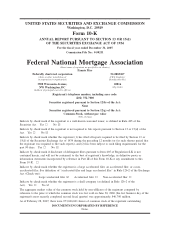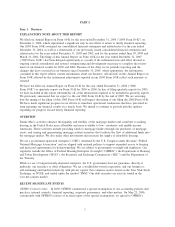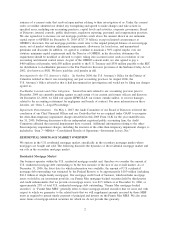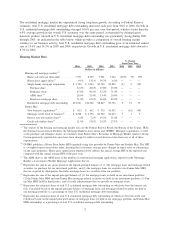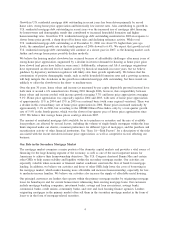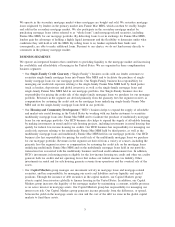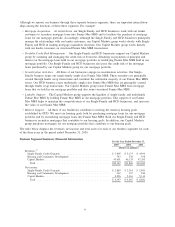Fannie Mae 2005 Annual Report Download - page 9
Download and view the complete annual report
Please find page 9 of the 2005 Fannie Mae annual report below. You can navigate through the pages in the report by either clicking on the pages listed below, or by using the keyword search tool below to find specific information within the annual report.Growth in U.S. residential mortgage debt outstanding in recent years has been driven primarily by record
home sales, strong home price appreciation and historically low interest rates. Also contributing to growth in
U.S. residential mortgage debt outstanding in recent years was the increased use of mortgage debt financing
by homeowners and demographic trends that contributed to increased household formation and higher
homeownership rates. Growth in U.S. residential mortgage debt outstanding moderated in 2006 in response to
slower home price growth, a sharp drop-off in home sales and declining refinance activity. While total
U.S. residential mortgage debt outstanding as of December 31, 2006 was about 9% higher than year-ago
levels, the annualized growth rate in the fourth quarter of 2006 slowed to 6.4%. We expect that growth in total
U.S. residential mortgage debt outstanding will continue at a slower pace in 2007, as the housing market cools
further and average home prices possibly decline modestly.
We believe the housing market slowdown has occurred because of affordability challenges after many years of
strong home price appreciation, augmented by a decline in investor demand for housing as home price gains
have slowed (and prices have fallen in some areas). Additionally, subprime and Alt-A mortgage originations
have represented an elevated level of market activity by historical standards in recent years, but we believe
guidance by depository institution regulators will likely slow their growth significantly. We believe that the
continuation of positive demographic trends, such as stable household formation rates and a growing economy,
will help mitigate this slowdown in the growth in residential mortgage debt outstanding, but these trends are
unlikely to offset the slowdown in the short- to medium-term.
Over the past 30 years, home values and income (as measured by per capita disposable personal income) have
both risen at around a 6% annualized rate. During 2001 through 2006, however, this comparability between
home values and income eroded, with income growth averaging 3.7% and home price appreciation averaging
9.1%. Home price appreciation was especially rapid in 2004 and 2005, with rates of home price appreciation
of approximately 11% in 2004 and 13% in 2005 on a national basis (with some regional variation). There was
a decline in this extraordinary rate of home price appreciation in 2006. Home prices increased nationally by
approximately 9.1% in 2006, but according to the OFHEO House Price Index, only by a four-quarter growth
rate of 5.9% in the fourth quarter, which was the slowest four-quarter pace of home price appreciation since
1999. We believe that average home prices could go down in 2007.
The amount of residential mortgage debt available for us to purchase or securitize and the mix of available
loan products are affected by several factors, including the volume of single-family mortgages within the loan
limits imposed under our charter, consumer preferences for different types of mortgages, and the purchase and
securitization activity of other financial institutions. See “Item 1A—Risk Factors” for a description of the risks
associated with the recent slowdown in home price appreciation, as well as competitive factors affecting our
business.
Our Role in the Secondary Mortgage Market
The mortgage market comprises a major portion of the domestic capital markets and provides a vital source of
financing for the large housing segment of the economy, as well as one of the most important means for
Americans to achieve their homeownership objectives. The U.S. Congress chartered Fannie Mae and certain
other GSEs to help ensure stability and liquidity within the secondary mortgage market. Our activities are
especially valuable when economic or financial market conditions constrain the flow of funds for mortgage
lending. In addition, we believe our activities and those of other GSEs help lower the costs of borrowing in
the mortgage market, which makes housing more affordable and increases homeownership, especially for low-
to moderate-income families. We believe our activities also increase the supply of affordable rental housing.
Our principal customers are lenders that operate within the primary mortgage market by originating mortgage
loans for homebuyers and for current homeowners refinancing their existing mortgage loans. Our customers
include mortgage banking companies, investment banks, savings and loan associations, savings banks,
commercial banks, credit unions, community banks, and state and local housing finance agencies. Lenders
originating mortgages in the primary market often sell them in the secondary mortgage market in the form of
loans or in the form of mortgage-related securities.
4

